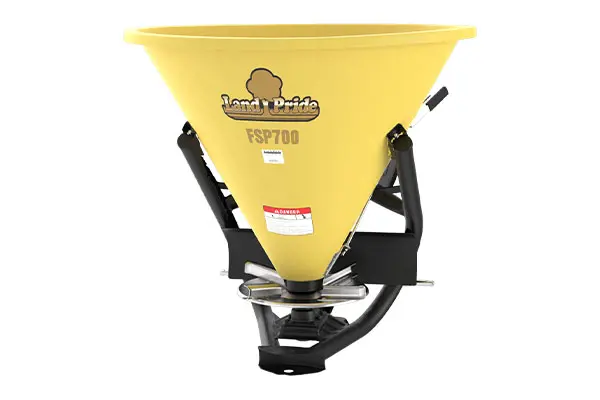Land Pride FSP 700 Cone Spreader: A Practical Option for Small Tractors
Tags: land-pride-landing
What is a Cone Spreader?
A cone spreader is a simple, three-point hitch attachment designed for tractors. It’s commonly used for spreading fertilizer, salt, or sand across large areas efficiently. Among the more popular choices is the Land Pride FSP 700, which offers a strong blend of affordability and utility for small property owners and light commercial use.
Land Pride FSP Series Overview
The FSP series includes three models: the FSP 500, FSP 700, and FSP 1000. These numbers don’t refer directly to capacity in pounds but to model designation. Approximate capacities are:
- FSP 500 – 350 lbs
- FSP 700 – 563 lbs
- FSP 1000 – 673 lbs
Each model shares the same frame, PTO shaft, and spinner system. The primary difference lies in the size of the hopper. It’s important to match the spreader’s size to your tractor’s capabilities. Overloading a small tractor with a large hopper isn’t practical or safe.
Build Quality and Design Notes
While the FSP 700 wears the Land Pride name, it’s likely sourced from a factory in Italy, a common origin for many spreaders on the market.
One critical area to evaluate on any cone spreader is the spinner assembly. In the FSP 700, the spinner is made from stainless steel, which holds up well against corrosive materials like fertilizer or salt. Painted steel spinners should be avoided, as they degrade quickly in these conditions.
Operating the FSP 700
Controlling the spread is simple. The gate control handle adjusts how much material flows out, and the PTO speed impacts how far material is thrown. A built-in chart helps guide spread rate, but actual application varies depending on tractor speed and field conditions.
Precision is not this unit’s strong suit. Spread pattern can favor one side more than the other, leading to uneven application. A common solution is to reduce your spread rate and make overlapping passes in both directions, often referred to as cross-hatching. This helps create a more uniform distribution.
Use Cases and Limitations
The FSP 700 is ideal for tasks like fertilizing fields or salting driveways. It’s not a great fit for high-value products like grass seed where accurate placement matters. If your goal is precision, consider a higher-end hopper spreader like Kubota’s VS Series, which uses a swinging spout for more controlled application.
Another challenge with cone spreaders is inconsistent flow toward the end of the load. As the hopper empties, the material flows more slowly, affecting spread consistency. That’s a tradeoff for the low cost and simplicity of the tool.
Maintenance Tips
After each use—especially when spreading fertilizer—it’s important to rinse off the spreader. Fertilizer residue can corrode metal components quickly, shortening the implement’s lifespan. Don’t forget to wash off the back of your tractor as well.
Is the FSP 700 Right for You?
The FSP 700 hits a sweet spot between cost and functionality. It’s simple to operate, relatively low-maintenance, and gets the job done with minimal effort. For general-purpose spreading of bulk materials where close-enough is good enough, it’s a solid pick. If you're dealing with delicate or costly materials where precision counts, another option might serve you better.














